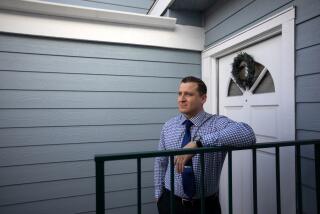Sales of New Homes Tumble; Analysts Foresee More Declines
WASHINGTON — Sales of new homes tumbled in November for the first time in five months, and analysts predicted further declines in 1995 as higher interest rates erode consumer demand.
Sales in the West--including California--fell 16.1% to a 177,000 annual rate.
“It’s clear this is the beginning,” said economist David Lereah of the Mortgage Bankers of America. “The housing sector is slowing.”
Joseph Blalock, an economist with the Savings & Community Bankers of America, agreed, saying that in addition to higher rates, a slower economy next year also will contribute to fewer homes sold.
Housing is one of the most interest-sensitive sectors of the economy. Many other areas have yet to feel the effects of six interest rate increases by the Federal Reserve Board this year to slow economic growth and avoid any major escalation of inflation.
The U.S. Chamber of Commerce, for instance, said Friday its business confidence index shot up to 65.2 in December, highest since its inception in May, 1990.
“On the economic front, businesses responded favorably to the robust but non-inflationary growth in the economy and the current indications of a strong Christmas season,” said economist Martin Regalia.
The chamber said its bimonthly survey found sizable jumps in economic outlook and in sales and employment expectations.
But new home sales fell 2.5% in November to a seasonally adjusted annual rate of 693,000, down from a revised 711,000 in October, the Commerce Department said Friday. It was the first decline since sales plunged 9.2% last June.
The report also showed the housing market was much weaker than previously thought in August, September and October. The October rate, for instance, originally was estimated to be 726,000.
The weakening housing market also was seen in sales of previously owned homes in November. The National Assn. of Realtors reported earlier this week that sales dropped to the lowest level in 17 months.
Many analysts had been predicting a housing slowdown for months as mortgage rates lurched upward.
Fixed-rate, 30-year mortgages averaged 9.18% in November, up from 8.93% in October and 7.15% last February, when the Fed began raising rates, according to the Federal Home Loan Mortgage Corp.
A jump from 7% to 9% would add $209 to the monthly payment on a $150,000 mortgage.
Still, job and income growth offset the higher cost for many home buyers, and others switched from fixed-rate mortgages to adjustable-rate loans with lower initial costs.
Despite the November sales decline, analysts do not foresee any overall collapse in the housing market.
Michael Carliner, an economist with the National Assn. of Home Builders, forecast new home sales will total 645,000 in 1995.
Although that would be down from an estimated 675,000 this year, it would be well above the recession levels of 534,000 in 1990 and 509,000 in 1991.
A seasonally adjusted 336,000 new homes were for sale in November, the largest amount since 339,000 in September 1990.
(BEGIN TEXT OF INFOBOX / INFOGRAPHIC)
New Home Sales
Seasonally adjusted annual rate, in thousands of units:
November 1994: 693
More to Read
Inside the business of entertainment
The Wide Shot brings you news, analysis and insights on everything from streaming wars to production — and what it all means for the future.
You may occasionally receive promotional content from the Los Angeles Times.










